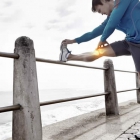Fix Your Knee Pain With These Simple Exercises

You’ve probably had a twinge or two of knee pain in your life. But just because knee pain is fairly common, that doesn’t mean it’s something you should have to live with. “The knee joint is arguably the most stressed joint in the human body,” says Richard Wilcock, a strength coach and owner of Flagship Fitness. “When you’re on your feet, the knee is taking the strain with over three quarters of your bodyweight pushing down on it.” It’s this constant strain that leads to pain as a byproduct of wear and tear, muscle imbalances, and even referral pain, where you feel pain somewhere else in your body. By and large, this pain is curable — as long as you know how to manage it.
[contentblock id=1 img=adsense.png]
First things first: Reduce your load. Remember that pain is your body’s way of saying, “Stop!” So when pain strikes, the obvious, though often ignored, first step is to lay off the activity causing the pain. “If running is your trigger, stay at a mileage or pace that doesn’t provoke your pain,” says Dr. Erin Weber, a physical therapist with Physio Logic. “If the pain comes on at the three-mile mark, stop at two and a half.”
The same concept applies to strength training. If your knees start hurting as you load more weight onto the barbell, reduce the load and stay at a resistance that doesn’t provoke the pain.
Read More: Partner Exercises that Will Get You Both Ripped
Tighten up your butt. It may seem odd, but weak glute muscles are often a key contributor to knee pain. “Your glutes are the mechanism that propels you forward — they are your powerhouse!” Weber says. But long days spent sitting can lead to a phenomenon coined by The Ohio State Wexner Medical Center researchers as “dormant butt syndrome.” Essentially, daily inactivity can lead to the tightening of your hip flexors and weakening of your glutes, forcing your surrounding musculature to correct for these imbalances. To undo the damage, you need to work on strengthening your glutes, particularly the abductor group, which includes your gluteus medius and minimus. These smaller glute muscles are often underused during physical activities like running, further contributing to pain. Weber suggests adding the following exercises to your routine:
[contentblock id=2 img=adsense.png]
Bridges: The basic bridge exercise targets the entire musculature of your backside as you lift and lower your hips from a supine position. Keep your core engaged throughout and really focus on squeezing your butt as you lift your hips as high as you can. As your glutes get stronger, progress to single-leg bridges.
Lateral Walks: Lateral walks provide an easy way to target your gluteus medius and minimus. To do them properly, place a looped resistance band around your lower legs and walk laterally, increasing tension on the band as you take each step.
Read More: 4 Seriously Underrated Ab Exercises
You can also add side-lying hip-abduction exercises, such as leg lifts and clamshells, to further target these smaller gluteal muscles.
Improve Your Balance. If you can’t easily stand on one foot without wobbling, chances are your body has grown accustomed to working muscles individually, rather than as a smooth, cohesive unit. This type of independent contraction further contributes to imbalances and poor mechanics. “Balance exercises are great for training muscles to co-contract,” Weber says. “Balancing also helps maintain ankle stability, creating more support for your knees.”
[contentblock id=3 img=gcb.png]
Give Some Love to Your Non-Dominant Side. Everyone has a dominant side. You probably tend to lean to one side, or cross one leg over the other, more often than you do your non-dominant side. For a day or two, this preference is no big deal, but over the course of 30 years? Those little imbalances can add up. Weber suggests training the lower body with unilateral exercises, such as single-leg mini-squats, lunges, step-ups, or single-leg deadlifts to help give your weaker side a chance to “catch up” to your dominant side.


